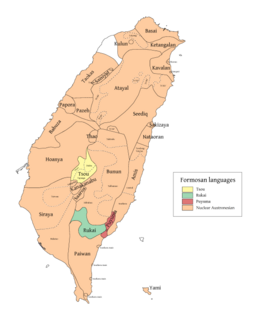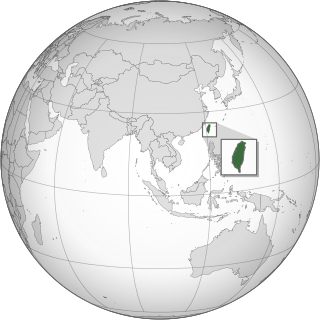 W
WThe Formosan languages are the languages of the indigenous peoples of Taiwan, all of which are Austronesian. The Taiwanese indigenous peoples recognized by the government are about 2.3% of the island's population. However, only 35% speak their ancestral language, due to centuries of language shift. Of the approximately 26 languages of the Taiwanese indigenous peoples, at least ten are extinct, another four are moribund, and all others are to some degree endangered.
 W
WAmis is the Formosan language of the Amis, an indigenous people living along the east coast of Taiwan. Currently the largest of the Formosan languages, it is spoken from Hualien in the north to Taitung in the south, with another population near the southern end of the island, though the northern varieties are considered to be separate languages.
 W
WThe Austronesian languages are a language family, widely spoken throughout Maritime Southeast Asia, Madagascar, the islands of the Pacific Ocean and Taiwan. There are also a few speakers in continental Asia. They are spoken by about 386 million people. This makes it the fifth-largest language family by number of speakers. Major Austronesian languages include Malay, Javanese, and Tagalog (Filipino). According to some estimates, the family contains 1,257 languages, which is the second most of any language family.
 W
WBabuza is a Formosan language of the Babuza and Taokas, indigenous peoples of Taiwan. It is related to or perhaps descended from Favorlang, attested from the 17th century.
 W
WBasay was a Formosan language spoken around modern-day Taipei in northern Taiwan by the Basay, Qauqaut, and Trobiawan peoples. Trobiawan, Linaw, and Qauqaut were other dialects.
 W
WThe Bunun language is spoken by the Bunun people of Taiwan. It is one of the Formosan languages, a geographic group of Austronesian languages, and is subdivided in five dialects: Isbukun, Takbunuaz, Takivatan, Takibaka and Takituduh. Isbukun, the dominant dialect, is mainly spoken in the south of Taiwan. Takbunuaz and Takivatan are mainly spoken in the center of the country. Takibaka and Takituduh both are northern dialects. A sixth dialect, Takipulan, became extinct in the 1970s.
 W
WThe East Formosan languages consist of various Formosan languages scattered across Taiwan, including Kavalan, Amis, and the extinct Siraya language. This grouping is supported by both Robert Blust and Paul Jen-kuei Li. Li considers the Siraya-speaking area in the southwestern plains of Taiwan to be the most likely homeland of the East Formosan speakers, where they then spread to the eastern coast of Taiwan and gradually migrated to the area of modern-day Taipei.
 W
WKavalan (Kebalan/kbalan) was formerly spoken in the Northeast coast area of Taiwan by the Kavalan people (噶瑪蘭). It is an East Formosan language of the Austronesian family.
 W
WKetagalan was a Formosan language spoken south of modern-day Taipei in northern Taiwan by the Ketagalan people. The language has become extinct.
 W
WThere are several hundred languages in China. The predominant language is Standard Chinese, which is based on central Mandarin, but there are hundreds of related Chinese languages, collectively known as Hanyu, that are spoken by 92% of the population. The Chinese languages are typically divided into seven major language groups, and their study is a distinct academic discipline. They differ as much from each other morphologically and phonetically as do English, German and Danish. There are in addition approximately 300 minority languages spoken by the remaining 8% of the population of China. The ones with greatest state support are Mongolian, Tibetan, Uyghur and Zhuang.
 W
WThe languages of Taiwan consist of several varieties of languages under families of Austronesian languages and Sino-Tibetan languages spoken in Taiwan. The Formosan languages, a branch of Austronesian languages, have been spoken by the Taiwanese aborigines in Taiwan for thousands of years. Researches on historical linguistics recognize Taiwan as the Urheimat (homeland) of the whole Austronesian languages family owing to the highest internal variety of the Formosan languages. In the last 400 years, several waves of Chinese emigrations brought several different Sino-Tibetan languages into Taiwan. These languages include Taiwanese Hokkien, Hakka, and Mandarin, which became the major languages of today's Taiwan and make Taiwan an important center of Hokkien pop and Mandopop.
 W
WThe Northern Formosan languages is a proposed grouping of Formosan languages that includes the Atayalic languages, the Western Plains languages, and the Northwest Formosan languages.
 W
WPaiwan is a native language of Taiwan, spoken by the Paiwan, a Taiwanese indigenous people. Paiwan is a Formosan language of the Austronesian language family. It is also one of the national languages of Taiwan.
 W
WThe Sinicized Papora and Hoanya dialects constituted a Formosan language of Taiwan. They were spoken across the middle western side of the island, around Lishui, Chingshui, Shalu, and inland to Taichung.
 W
WPazeh is an extinct language of the Pazeh, a Taiwanese aboriginal people. It was a Formosan language of the Austronesian language family. The last remaining native speaker of Pazeh proper, Pan Jin-yu, died in 2010 at the age of 96. Before her death, she offered Pazeh classes to about 200 regular students in Puli and a small number of students in Miaoli and Taichung. Kulun was a dialect that became extinct earlier. The insulting name "fan" was used against Plains Aborigines by the Han Taiwanese, and the Hoklo Taiwanese speech was forced upon Aborigines like the Pazeh. Hoklo Taiwanese has replaced Pazeh and driven it to extinction. Aboriginal status has been requested by Plains Aboriginals.
 W
WThe Puyuma language, or Pinuyumayan, is the language of the Puyuma, an indigenous people of Taiwan. It is a divergent Formosan language of the Austronesian family. Most speakers are older adults.
 W
WRukai is a Formosan language spoken by the Rukai people in Taiwan. It is a member of the Austronesian language family. The Rukai language comprises six dialects, which are Budai, Labuan, Maga, Mantauran, Tanan and Tona. The number of speakers of the six Rukai dialects is estimated to be about 10,000. Some of them are monolingual. There are varying degrees of mutual intelligibility among the Rukai dialects. Rukai is notable for its distinct grammatical voice system among the Formosan languages.
 W
WSaaroa or Hla’alua is a Southern Tsouic language is spoken by the Saaroa (Hla'alua) people, an indigenous people of Taiwan. It is a Formosan language of the Austronesian family.
 W
WSaisiyat is the language of the Saisiyat, a Taiwanese indigenous people. It is a Formosan language of the Austronesian family. It has approximately 4,750 speakers.
 W
WSakizaya is a Formosan language closely related to Amis. One of the large family of Austronesian languages, it is spoken by the Sakizaya people, who are concentrated on the eastern Pacific coast of Taiwan. Since 2007 they have been recognized by the Taiwan government as one of the sixteen distinct indigenous groups on the island.
 W
WThe Sinckan Manuscripts refers to a series of leases, mortgages, and other commerce contracts written in Sinckan, Taivoan, and Makatao; they are commonly referred to as the "fanzi contracts". Some are written only in a romanized script, while others were bilingual with adjacent Han writing. Currently there are approximately 140 extant documents written in Sinckan; they are important in the study of Siraya and Taivoan culture, and Taiwanese history in general although there are only a few scholars who can understand them.
 W
WSiraya is a Formosan language spoken until the end of the 19th century by the indigenous Siraya people of Taiwan, derived from Proto-Siraya. Some scholars believe Taivoan and Makatao are two dialects of Siraya, but now more evidence shows that they should be classified as separate languages.
 W
WTaivoan or Taivuan, is a Formosan language spoken until the end of the 19th century by the indigenous Taivoan people of Taiwan. Taivoan used to be regarded as a dialect of Siraya, but now more evidence has shown that they should be classified as separate languages. The corpora previously regarded as Siraya like the Gospel of St. Matthew and the Notes on Formulary of Christianity translated into "Siraya" by the Dutch people in the 17th century should be in Taivoan majorly.
 W
WTsou is a divergent Austronesian language spoken by the Tsou people of Taiwan. Tsou is a threatened language; however, this status is uncertain. Its speakers are located in the west-central mountains southeast of the Chiayi/Alishan area in Taiwan.
 W
WThe Tsouic languages are three Formosan languages, Tsou proper and the Southern languages Kanakanabu and Saaroa. The Southern Tsouic languages of Kanakanabu and Saaroa have the smallest phonemic inventories out of all the Formosan languages, with each language having only 13 consonants and 4 vowels. These two languages are highly endangered, as many Southern Tsouic speakers are shifting to Bunun and Mandarin Chinese.